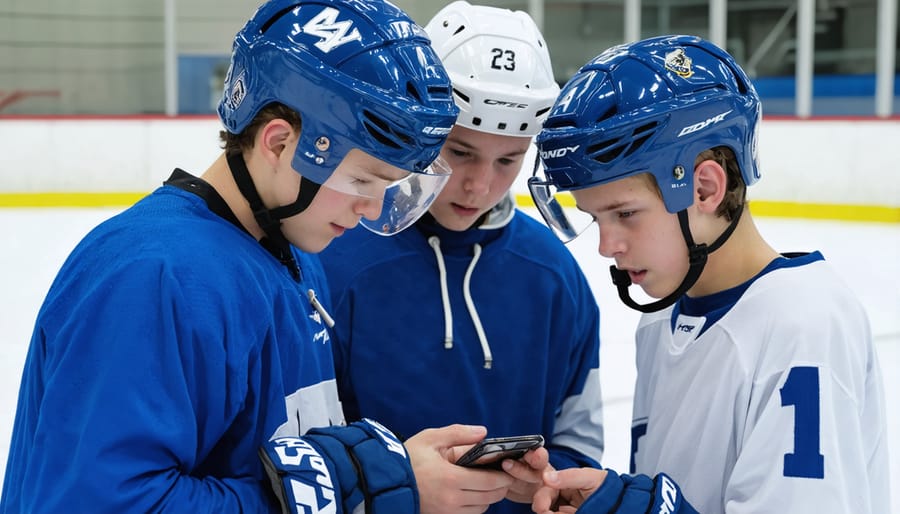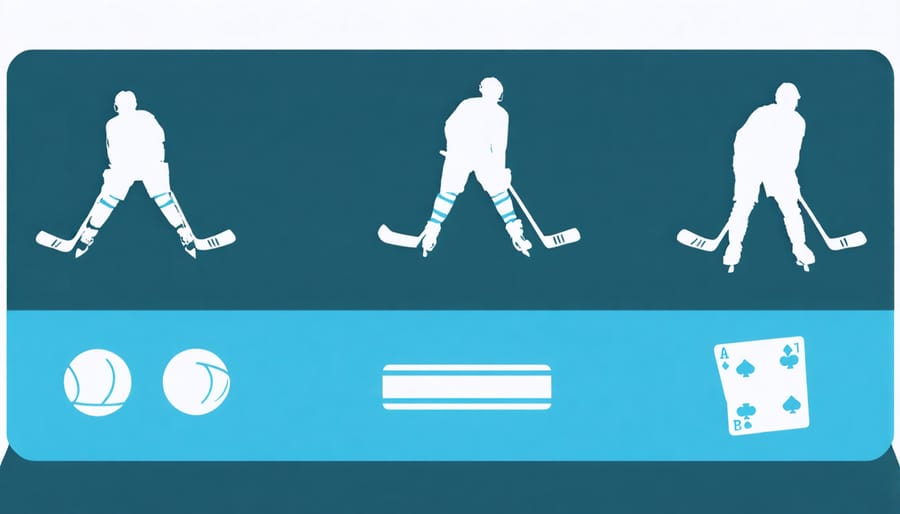The alarming rise of online sports betting platforms where Bitcoin is accepted has created an urgent need to protect young hockey players from gambling risks. As youth hockey coaching responsibilities continue to evolve, addressing gambling prevention has become as crucial as teaching proper skating technique or team strategy. Recent studies show that athletes exposed to gambling education programs during their developmental years are 60% less likely to develop problematic betting behaviors later in life.
The intersection of technology, sports, and easily accessible betting platforms presents unique challenges for today’s youth hockey community. With smartphones providing 24/7 access to sports betting apps and social media constantly promoting odds and betting lines, young players need comprehensive guidance now more than ever. This education isn’t just about preventing future addiction – it’s about fostering a healthy relationship with the sport, understanding its true values, and developing critical thinking skills that extend far beyond the rink.
By implementing structured gambling awareness programs within youth hockey organizations, we can equip our young athletes with the knowledge and resilience they need to navigate these challenges while maintaining their focus on personal growth, skill development, and the pure joy of the game.
The Rising Tide of Sports Betting in Youth Hockey
Understanding the Digital Gambling Landscape
Today’s digital landscape has made sports betting more accessible than ever, particularly through mobile apps and online platforms. Young hockey players are increasingly exposed to betting advertisements during games, on social media, and through gaming-style apps that blur the line between entertainment and gambling. Popular betting platforms often feature user-friendly interfaces, attractive promotional offers, and seamless integration with sports content, making them particularly appealing to tech-savvy youth.
The accessibility of these platforms presents unique challenges, as many require minimal age verification and can be accessed through various devices. Fantasy sports apps and prediction games, which may seem harmless, often serve as gateways to more serious betting activities. Social media platforms frequently display targeted betting advertisements, while streaming services and sports websites commonly feature betting odds and promotional content.
Understanding this digital environment is crucial for protecting young athletes. Many betting platforms incorporate social elements and game-like features that can be particularly engaging for younger users, potentially normalizing gambling behavior within sports culture. This understanding helps educators and parents identify risk factors and implement effective preventive measures.

Warning Signs of Youth Gambling Behavior
Recognizing problematic gambling behavior early is crucial for protecting young athletes. Like other youth athlete risk behaviors, gambling addiction often presents subtle signs before becoming severe. Parents and coaches should watch for players who frequently discuss betting odds, sports betting apps, or gambling websites. Changes in behavior, such as increased secrecy with electronic devices, unexplained money issues, or borrowing from teammates, can indicate potential problems.
Be alert if players show intense preoccupation with game scores unrelated to their own team’s performance, or if they express unusual knowledge about betting lines and spreads. Missing practices or games due to unexplained reasons, declining academic performance, or sudden mood changes might also signal gambling involvement.
Additional red flags include players asking for advanced allowances, selling personal items, or displaying anxiety when unable to access their phone during practice. If multiple warning signs appear, it’s essential to address concerns promptly and seek professional guidance to prevent the development of serious gambling issues.
Building a Protective Educational Framework

Age-Appropriate Discussion Strategies
Discussing gambling risks with young hockey players requires tailored approaches based on their age and maturity level. For players aged 8-11, focus on building foundational understanding through simple concepts and relatable examples. Use storytelling to explain the difference between skill-based hockey activities and chance-based gambling, emphasizing that success in hockey comes from practice and dedication.
With players aged 12-14, introduce more specific conversations about online gaming and in-app purchases, as this age group often begins exploring digital platforms. Discuss how certain gaming mechanics can mimic gambling behaviors, using examples like loot boxes or player card collections in hockey-themed games. Encourage critical thinking by asking them to identify potentially risky situations.
For high school players (15-18), address the topic directly while acknowledging their increasing independence. Share real-world examples of athletes who’ve faced gambling challenges, discuss the legal implications, and explore how gambling can impact athletic careers. Focus on developing responsible decision-making skills and understanding the importance of seeking help when needed.
Regardless of age, maintain open dialogue and create a supportive environment where players feel comfortable asking questions. Use team meetings, individual check-ins, and parent-coach conferences to reinforce these messages. Incorporate discussion opportunities during relevant moments, such as when covering topics like sportsmanship and team values.
Remember to adapt your communication style and complexity of information based on players’ comprehension levels. For younger athletes, use visual aids and interactive activities, while older players might benefit from peer-led discussions and real-life case studies.
Team Policy Development
Developing comprehensive team policies around gambling is essential for positive youth development through hockey. Organizations should establish clear, written guidelines that address both traditional and online gambling risks, making them accessible to players, parents, and staff.
Key policy elements should include strict prohibitions on any gambling activities during team events, clear consequences for violations, and guidelines for responsible social media use. Teams should implement a zero-tolerance approach to gambling-related harassment or pressure among teammates.
Programs should require all coaches, staff members, and volunteers to undergo gambling awareness training annually. This ensures they can recognize warning signs and respond appropriately to concerns. Regular policy reviews and updates are necessary to address emerging gambling trends and technologies.
Communication is crucial – policies should be presented during pre-season meetings and reinforced throughout the year. Consider creating age-appropriate versions of the guidelines to ensure younger players understand the expectations. Include specific protocols for reporting concerns and accessing support services.
Parents should be required to acknowledge these policies in writing, creating a partnership in protecting young athletes. Teams can strengthen their approach by collaborating with local gambling prevention organizations and mental health professionals to review and enhance their policies.
Document all gambling-related incidents and policy enforcement actions to maintain consistency and identify potential areas for improvement. Regular feedback from players, parents, and coaches helps ensure policies remain effective and relevant to the current youth hockey environment.

Empowering Players to Make Informed Choices
Building Financial Literacy
Financial literacy serves as a crucial foundation for young hockey players navigating the modern sports landscape. Understanding money management helps athletes make informed decisions and recognize potential gambling risks. By introducing basic financial concepts early, we equip young players with the tools to resist the allure of quick-money schemes and gambling advertisements.
Start by teaching players about budgeting, savings, and the value of money earned through hard work. Create practical exercises that demonstrate how gambling can quickly deplete savings and discuss the statistical improbability of “getting rich quick” through betting. Use real-world examples from professional sports to illustrate the financial pitfalls that have affected athletes who developed gambling problems.
Encourage open discussions about the relationship between sports and money, including how gambling companies target young athletes through social media and gaming platforms. Teach players to recognize manipulative marketing tactics and understand the difference between strategic financial planning and high-risk gambling behaviors.
Involve parents and guardians in financial education efforts, providing them with resources to continue these conversations at home. Consider partnering with financial experts who can present age-appropriate workshops focusing on smart money management and the long-term benefits of financial responsibility.
Remember that building financial literacy is an ongoing process. Regular check-ins and updated educational materials help reinforce these important lessons as players progress through their hockey careers.
Developing Healthy Coping Mechanisms
Young athletes face significant pressures in competitive hockey, making it crucial to develop healthy ways to manage stress and emotions. Instead of turning to potentially harmful outlets like gambling, players can build a toolkit of positive coping strategies that enhance both their athletic and personal development.
Physical activities like controlled breathing exercises and progressive muscle relaxation can help players manage pre-game jitters and performance anxiety. Implementing a consistent pre-game routine that includes these techniques helps create a sense of control and stability.
Team-building activities and peer support systems provide valuable emotional outlets. Encouraging players to share their experiences and challenges with teammates fosters a supportive environment where stress can be addressed openly and constructively. Regular team discussions about pressure management help normalize these conversations and strengthen group resilience.
Creative expression through journaling, music, or art offers healthy alternatives for processing emotions. These activities provide safe spaces for players to explore their feelings away from the intensity of competition. Additionally, mindfulness practices and visualization techniques can help athletes maintain focus while reducing anxiety.
Engaging in non-hockey activities and maintaining balanced social connections helps prevent unhealthy fixation on game outcomes. Encouraging players to pursue diverse interests and hobbies creates natural stress relief valves and promotes well-rounded development. This balanced approach helps young athletes build lasting emotional management skills that serve them both on and off the ice.
Creating a Supportive Environment
Parent-Coach Collaboration
Effective protection against gambling risks requires a united front between parents and coaches. By establishing clear communication channels and shared responsibilities, we can create a stronger support system for young hockey players.
Parents should regularly update coaches about any concerning behaviors they observe at home, such as increased interest in sports betting apps or excessive discussion of game odds. Similarly, coaches need to inform parents about team policies regarding gambling-related conversations and any suspicious activities noticed during practice or games.
Create a mutual agreement on monitoring social media use and online activities during team events. Parents can help reinforce the coach’s messages about the dangers of gambling, while coaches can provide educational resources and organize workshops that include both players and their families.
Consider implementing a “see something, say something” policy where both parents and coaches commit to reporting any gambling-related concerns immediately. This collaborative approach helps identify potential issues early and ensures consistent messaging about responsible gaming behavior.
Regular parent-coach meetings should include updates on gambling prevention strategies and discussions about new trends in youth sports betting. Working together, parents and coaches can also develop alternative activities that channel players’ competitive spirit into healthy outlets, such as skills competitions or team-building exercises.
Remember that young athletes are more likely to make positive choices when they see adults in their lives working together to support their well-being.
Resource Networks and Support Systems
Support networks play a crucial role in protecting young athletes from gambling-related risks, and numerous organizations have developed specialized youth hockey development programs that include gambling prevention components. The National Problem Gambling Helpline offers 24/7 confidential support, while organizations like GameSense provide educational resources specifically tailored for young athletes and their families.
Local hockey associations have established mentor programs where experienced players and coaches guide younger athletes through the challenges they may face, including pressure from gambling advertisements and peer influence. These mentorship initiatives create safe spaces for open discussions about gambling risks and healthy decision-making.
Parents and coaches can access specialized training through organizations like the Hockey Canada Safety Program, which now includes modules on protecting young players from gambling influences. Additionally, professional sports psychologists and counselors who specialize in youth athletics offer valuable support services and prevention strategies.
Many communities have formed support groups that bring together families affected by gambling issues, creating a network of understanding and shared experiences. These groups often collaborate with local youth sports organizations to implement preventive measures and early intervention strategies.
For immediate assistance, the Youth Gambling Prevention Hotline connects young athletes with trained professionals who understand the unique pressures of competitive sports environments. Resources are available in multiple languages, ensuring accessibility for all hockey families.
The protection of young hockey players from gambling risks requires a united front of educators, coaches, parents, and the broader hockey community. By implementing comprehensive education programs and maintaining open dialogues about gambling risks, we create a safer environment where athletes can focus on their development both on and off the ice.
The stakes are too high to remain passive about gambling education. As technology evolves and access to online betting platforms becomes increasingly prevalent, our responsibility to educate and protect young athletes grows correspondingly. Regular workshops, ongoing monitoring of online activities, and strong support systems must become standard components of youth hockey programs.
Success in this endeavor requires consistent reinforcement of positive values and decision-making skills. By emphasizing the importance of integrity in sports and helping young players understand the real risks associated with gambling, we strengthen their ability to make informed choices throughout their athletic careers and beyond.
Looking ahead, the hockey community must remain vigilant and adaptable in its approach to gambling prevention. This includes staying informed about emerging trends in online gambling, updating educational materials regularly, and fostering environments where young athletes feel comfortable discussing concerns about gambling pressures.
Together, we can ensure that the next generation of hockey players develops in an environment that prioritizes their wellbeing and supports their journey toward becoming responsible athletes and citizens.


